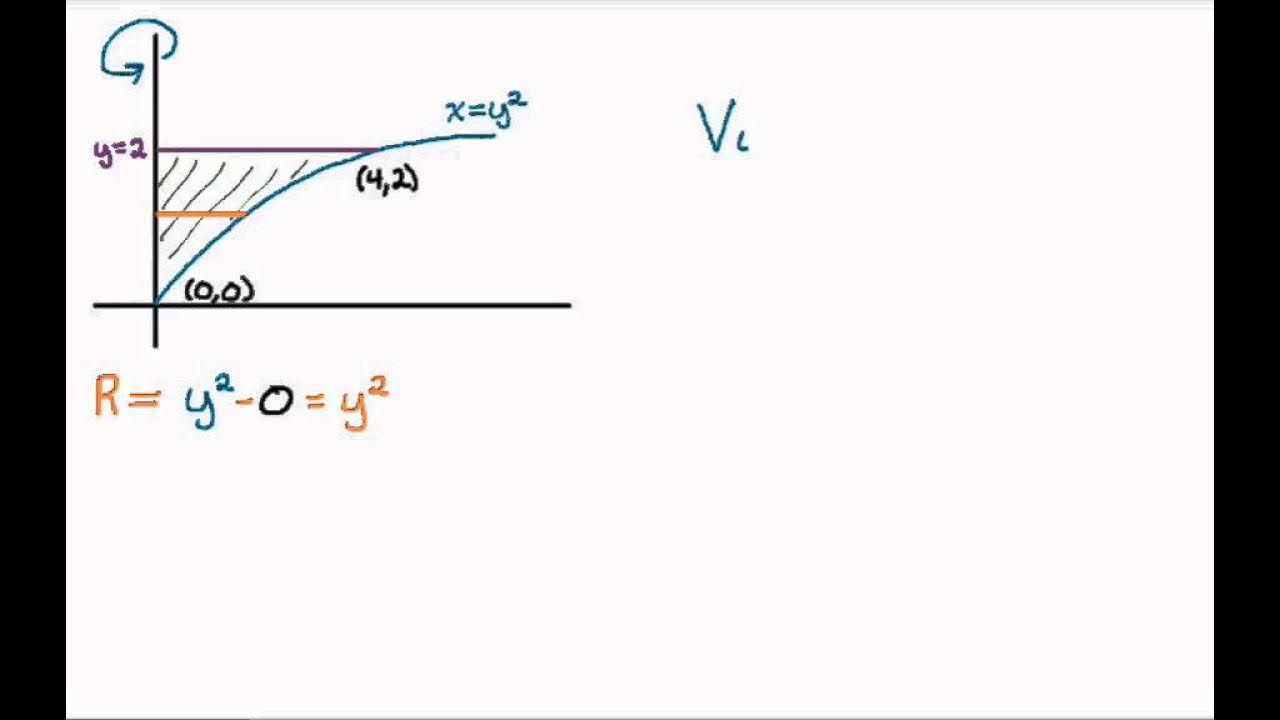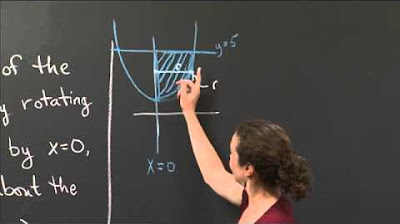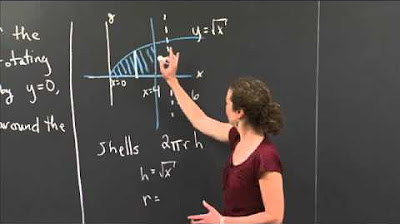Volume of Revolution Examples - Horizontal Axis
TLDRThis video tutorial demonstrates the process of calculating the volume of a solid formed by rotating a region around a horizontal axis. The first example involves rotating the region bounded by y=√x and y=2 around the x-axis. The presenter identifies the intersection points, establishes the bounds of the region, and sets up the volume integral using the difference of the squares of the outer (y=2) and inner (y=√x) radii. After integrating and substituting the bounds, the result is a volume of 8π. The second example is structurally similar, rotating the same region around y=3, but with different radii: the outer radius being 3 - √x and the inner radius being a constant 1. The integral is simplified and integrated, resulting in the same volume of 8π. The video emphasizes the importance of graphing the region accurately and choosing positive radii for clarity in calculations.
Takeaways
- 📈 To find the volume of a solid of revolution, you need to identify the region to be rotated and the axis of rotation.
- 📊 The intersection points of the functions that define the region are crucial for setting up the integral.
- 🔍 Create a graph to visualize the region and its boundaries accurately.
- 🎯 Identify the outer and inner radii for the volume integral based on the axis of rotation.
- ⭕ For rotation around the x-axis, the outer radius is a constant (2 in the first example), and the inner radius is a function of x (sqrt(x)).
- ⭕ For rotation around a vertical line (y=3 in the second example), the outer radius is a function of x (3 - sqrt(x)), and the inner radius is a constant (1).
- 🧮 The volume integral is set up as π * ∫[outer radius squared - inner radius squared] dx.
- 🔢 Perform the integration within the bounds of the region, from 'a' to 'b'.
- 🧹 Simplify the integrand before integrating to avoid complex calculations.
- 📐 Convert radicals to rational exponents to simplify the integration process.
- 🏁 Substitute the bounds of integration into the simplified integral to find the volume.
- 🔁 In both examples, the final volume of the solid of revolution is the same (8π), which is a coincidence.
- 🎓 These examples demonstrate the process of finding the volume by disks and washers around different axes.
Q & A
What is the topic of the video?
-The video is about calculating the volume of a solid formed by rotating a region around a horizontal axis using the disk and washer methods.
What are the equations of the curves that define the region for the first problem?
-The region is bounded by y = √x and y = 2.
What is the axis of rotation for the first problem?
-The region is rotated around the x-axis.
How does one determine the bounds for the volume integral in the first problem?
-The bounds are determined by the intersection points of the curves and the axis of rotation, which are y = 0 (x-axis) and y = 2.
What is the outer radius (R) for the first problem?
-The outer radius R is 2 - 0, which simplifies to 2.
What is the inner radius (r) for the first problem?
-The inner radius r is √x - 0, which simplifies to √x.
What is the final volume obtained for the first problem?
-The final volume obtained for the first problem is 8π.
What is the axis of rotation for the second problem?
-The region is rotated around the line y = 3 for the second problem.
How does the big radius differ in the second problem compared to the first?
-In the second problem, the big radius is 3 - √x, as opposed to 2 in the first problem.
What is the small radius for the second problem?
-The small radius for the second problem is 3 - 2, which simplifies to 1.
What is the integral set up for calculating the volume in the second problem?
-The integral set up is π times the integral from 0 to 4 of (3 - √x)^2 - 1^2 dx.
What is the final volume obtained for the second problem?
-The final volume obtained for the second problem is also 8π, which is the same as the first problem.
Why did the final volume for both problems end up being the same?
-The final volume for both problems ended up being the same due to the specific shape and size of the region being rotated and the way the washer method calculates volume, which depends on the difference in the squares of the radii.
Outlines
📈 Calculating Volume of Solids by Disks and Washers: Horizontal Axis Rotation
The video begins with an introduction to calculating the volume of a solid formed by rotating a region around a horizontal axis. The region is bounded by the functions y = √x and y = 2, with x = 0. The presenter emphasizes the importance of graphing the region accurately to identify the intersection points and establish the bounds for integration. The region to be rotated is shaded for clarity. The axis of rotation is marked with an arrow, and the intersection point is identified. The presenter then calculates the radius for the outer and inner edges of the region, which are 2 - 0 = 2 and √x - 0 = √x, respectively. The volume integral is set up as π * ∫[a, b] (R² - r²) dx, where R and r are the big and small radii, respectively. After simplifying and integrating, the final volume is found to be 8π. The presenter then proceeds to solve a similar problem but with a different axis of rotation, y = 3, and demonstrates the process of finding the new radii and integrating to find the volume, which, interestingly, also results in 8π.
Mindmap
Keywords
💡Volume by Disks and Washers
💡Horizontal Axis
💡Region Bounded by Functions
💡Intersection Points
💡Graph
💡Big Radius and Little Radius
💡Volume Integral
💡Integration Bounds
💡Simplifying the Integrand
💡Antiderivative
💡Fundamental Theorem of Calculus
💡Substitution
Highlights
The video demonstrates the calculation of the volume of a solid formed by rotating a region bounded by y=√x, y=2, and x=0 around the x-axis.
To solve the problem, one must first create an accurate graph to identify the region and intersection points.
The region of interest is between y=√x and y=2, including the y-axis.
The axis of rotation is identified with an arrow, and the point of intersection is established to set the bounds for the integral.
The outer edge of the region corresponds to y=2, providing the larger radius for the volume integral.
The inner edge is represented by y=√x, which gives the smaller radius for the volume calculation.
The volume integral is set up as π * ∫[a, b] (R^2 - r^2) dx, where R is the larger radius and r is the smaller radius.
The integral is simplified to π * ∫[0, 4] (4 - x) dx after identifying the bounds and simplifying the expression.
The final volume obtained after integrating is 8π, representing the volume of the solid when rotated around the x-axis.
The same region is considered for a second problem, but this time the rotation is around y=3.
The graph is redrawn with the new axis of rotation, y=3, to find the new radii for the volume calculation.
The larger radius for the second problem is determined as 3 - √x, ensuring it remains positive for calculation purposes.
The smaller radius is a constant, 1, derived from the difference between y=3 and y=2.
The volume integral for the second problem is π * ∫[0, 4] (R^2 - r^2) dx, with the new radii values.
The integrand is simplified and the radical is converted into a rational exponent for easier integration.
The bounds of integration are substituted, and the integral is solved, yielding the same volume of 8π for the second problem.
The coincidence of obtaining the same volume for both problems is noted, highlighting the importance of the axis of rotation.
The video concludes with a summary of the process and offers encouragement for further learning.
Transcripts
Browse More Related Video

Volume of Revolution Examples - Vertical Axis

Volume of a Paraboloid via Disks | MIT 18.01SC Single Variable Calculus, Fall 2010

2011 Calculus AB free response #3 (c) | AP Calculus AB | Khan Academy

Volume of Revolution via Shells | MIT 18.01SC Single Variable Calculus, Fall 2010

Disc method rotating around vertical line | AP Calculus AB | Khan Academy

Solid of revolution between two functions (leading up to the washer method) | Khan Academy
5.0 / 5 (0 votes)
Thanks for rating: